
94% of researchers rate our articles as excellent or good
Learn more about the work of our research integrity team to safeguard the quality of each article we publish.
Find out more
ORIGINAL RESEARCH article
Front. Psychol., 05 July 2024
Sec. Addictive Behaviors
Volume 15 - 2024 | https://doi.org/10.3389/fpsyg.2024.1339751
Introduction: The Avenir Santé Association implemented a comprehensive prevention program targeting the consumption of the emerging psychoactive substances ecstasy (MDMA), cannabidiol (CBD), and nitrous oxide (N2O).
Methods: The program was evaluated through four actions: (i) training for association workers (n = 84) (ii) on-site student party interventions (n = 248), (iii) social network-based prevention (n = 186), and (iv) provision of prevention tools for party organizers (n = 148).
Results: Results showed a significant increase in understanding of emerging substances among association workers, with a pre-training score of M = 15.76 (SD = 3.65) and a post-training score of M = 18.29 (SD = 2.50). Increased awareness and reflective attitudes toward substance use were observed among young people participating in field actions, with pre- and post-intervention scores for MDMA use intentions being M = 15.89 (SD = 4.60) and M = 19.17 (SD = 3.33), respectively. Similarly, awareness of CBD effects increased from M = 14.18 (SD = 4.14) to M = 17.60 (SD = 3.31). Exposure to Instagram posts on N2O led to more negative attitudes toward N2O among young people, with a significant change in scores from M = 8.16 (SD = 1.57) to M = 8.42 (SD = 1.26). However, exposure to a website providing information about emerging substances did not produce any significant effect.
Discussion: In conclusion, this initiative underscores the usefulness of facilitator training, field interventions, and certain online information strategies for substance judgment and usage intentions. Future prevention programs can advantageously incorporate these actions.
The 2022 ESCAPAD survey (Enquête sur la santé et les comportements lors de la préparation à la défense) found a decrease in the use of substances such as tobacco, alcohol and cannabis among the French compared to 2000 (OFDT, 2023). For example, Experimentation with tobacco (at least once in a lifetime) fell from 77.6 percent to 45.5 percent; with alcohol from 94.6 percent to 80.6 percent; and with cannabis from 45.6 percent to 29.9 percent. In contrast, the use of newer substances, including ecstasy (MDMA), despite its longstanding use, has exhibited a notable rise in recent times. Similarly noteworthy are the increases observed in the use of nitrous oxide (N2O) and cannabidiol (CBD) (Wheeler et al., 2020; Ponce-Blandón et al., 2021; Ferreira et al., 2022; Inquimbert et al., 2022; Cohen et al., 2023). This increased usage has been accompanied by normalization of substance use among students, with fewer viewing such substance use as problematic (van den Bos et al., 2022). Long-term effects of MDMA, with reduced attention control (Peroutka, 1989; Vollenweider et al., 2002; Cole and Sumnall, 2003; Parrott, 2005; Piper, 2007), and of N2O, with the development of neuropathies, are well-known (Lundin et al., 2019; Redmond et al., 2022). However, the negative impacts of long-term CBD use remain largely unknown, although some research points to potential effects on attention and vigilance, especially in psychiatric patients (Millar et al., 2019; Batalla et al., 2021; Rudisill et al., 2023). The scientific literature has highlighted several criteria for the effectiveness of a preventive action [see for example (Kempf et al., 2017)]. First, it is important to act on multiple levers rather than a single action. Indeed, one of the most influential explanatory models of substance use in psychology, the theory of planned behavior (Ajzen, 1991), shows that behavioral motivation is influenced by, among other things, peers, environmental social norms, and the individual’s own representations. These different interactions highlight the importance of interventions that target these different sources of behavioral influence [(see Kempf et al., 2017) for more details on the different models]. It is also important to train the professionals who are in contact with the students concerned in order to ensure a change in social norms in the students’ immediate environment. In the same spirit, it is important to be able to carry out the action in places where students are present (in particular social networks or party venues). Avenir Santé Association has addressed these trends with a preventive program for 18–25-year-olds, encompassing staff training, outreach initiatives in student party venues, prevention awareness via social media, and provision of prevention tools for party organizers (Flaudias et al., 2015; Kempf et al., 2017). The purpose was to bolster knowledge and self-efficacy to instigate preventive actions, and to evaluate the impact of these actions in different environments.
This prevention project was designed to engage young individuals and key influencers within their environments to reduce the use of emerging psychoactive substances such as MDMA, CBD, and N2O. The project’s objective was to enhance knowledge, self-efficacy, and awareness of substance use among specific target groups, including workers, adolescents, social media users, and event organizers. Through both direct and indirect engagement strategies, the initiative sought to encourage the adoption of informed and preventative behaviors among these communities.
This strategy included both direct contact with the target group of young people and indirect engagement with the professionals that students might encounter during this period of their lives. The project was divided into four separate preventive actions.
a. Action 1—Training intervention specialists: The first step was to equip a group of professionals with the knowledge and skills to disseminate awareness and prevention messages effectively. Training emphasized a comprehensive understanding of substance misuse and its consequences, forceful communication skills, and insight into the psychological and behavioral repercussions of substance use.
b. Action 2—Direct actions with youth through in-person outreach: The next phase involved direct interaction with youth at their common gathering spots. Outreach teams, separate from the trained individuals in Action 1, initiated face-to-face engagements to give personalized advice, correct misconceptions, and build rapport.
c. Action 3—Social media awareness campaign: To leverage the widespread influence of social media among youth, the project used digital platforms (e.g., Instagram) for educational messaging about psychoactive substance risks. This approach utilized the convenience and broad reach of social media, creating an interactive space for discussion and learning.
d. Action 4—Web support for party organizers: The project aimed to inform actors creating potential substance use environments by providing a dedicated webpage for party organizers. This resource offered vital information about psychoactive substances, tips on identifying misuse signs, emergency handling, and overall attendee safety, thus expanding the network of informed individuals to help reduce substance misuse.
Each action was evaluated separately.
Action 1 (Training intervention specialists) participants in Action 1 had to be volunteers from the Avenir Santé association who had attended the specialized training course on new psychoactive substances. They must have given informed consent to participate and completed both the pre- and post-training questionnaires. Exclusion criteria were those who did not give informed consent, or those who did not complete both questionnaires. Eighty-four volunteers from the Avenir Santé Association attended a specialized training course on emergent psychoactive substances and prevention of their use. Participants were asked to complete a questionnaire twice—once before the beginning of the training (pre-training) and once after the conclusion of the training (post-training). Number of correct responses was taken as the primary measure of the training’s effectiveness. The materials for evaluating knowledge related to emerging substances included a specially designed questionnaire, tailored to assess the impact of the training on knowledge about emerging substances. It comprised three main sections, each addressing one substance: nitrous oxide (7 items), MDMA (7 items), and CBD (6 items) (see Appendix A for more details). Each section comprised multiple-choice questions that probed the respondents’ understanding of the effects of the substance (e.g., “What effects do consumers look for?”), how it is consumed (e.g., “What are the different ways it is consumed?”), and viable strategies for reducing its use (e.g., “What risk and harm reduction advice could you give?”).
Action 2 (Direct actions with youth through in-person outreach) aimed to assess the impact of interactions with Avenir Santé Association outreach teams on participants’ knowledge about the effects of different substances and their intentions to reduce their use. Inclusion criteria for Action 2 required participants to be young adults above the age of 18 who were present at student party venues where Avenir Santé Association conducted outreach interventions. They had to provide informed consent and participate in the outreach sessions. Participants were excluded if they were not in the target age range, did not provide consent, or were not present at the intervention sites. The evaluation aimed to compare the effects of outreach interventions focused on emerging substances (N2O, MDMA, CBD) with those focused on more familiar substances (alcohol and tobacco). (See Appendix B for questionnaires on attitudes and intentions). Each member of the outreach team discussed the use of one or more emerging substance (MDMA, CBD, N2O) or alcohol and tobacco with the people they approached. Depending on the substance for which the outreach was conducted, the respondent completed the appropriate questions on attitudes and use intentions. Volunteers from the “Avenir Santé Association” gave participants at festive events a form presenting the risks associated with consuming one or more emerging substance and/or alcohol and tobacco. Sociodemographic data (age, sex, place of residence) were also collected. The total sample consisted of 248 persons from various regions in France (mean age 21.9 years, SD = 3.86, 48.6% female).
Action 3 (Raising awareness through social media) focused on assessing the impact of Instagram posts from an online prevention campaign. We evaluated Instagram posts that formed part of a real prevention campaign (there were 672,797 interactions with the posts concerning N2O, summing views, likes, and shares) on the consumption of (i) alcohol or (ii) N2O regarding their impact on attitudes and intentions to consume them among students at two French Universities. Since it was difficult to evaluate the target group directly without jeopardizing the effectiveness of the intervention, we proposed an evaluation of a group of students who corresponded to the target group (age and diversity of profiles). Participants in Action 3 interacted with Instagram posts as part of an online prevention campaign and were young adults, who were students at the Universities of Nantes and Nanterre. Inclusion required informed consent and participation in the online study. Exclusion criteria included being outside the age range or not giving consent. Participants took part in an online study in which they were asked to report their attitudes and intentions to consume alcohol and N2O. Each participant was randomly assigned to an experimental condition where they viewed either (i) six posts on N2O (N2O exposure condition) or (ii) six posts on alcohol (alcohol-exposure condition). In both conditions, we measured participants’ attitudes and consumption intentions before and after they were exposed to the Instagram posts. The attitudes were evaluated on four scales that measured perceptions of healthiness (from 1: unhealthy to 9: healthy), wisdom (from 1: unwise to 9: wise), goodness (from 1: bad to 9: good), and safety (from 1: unsafe to 9: safe) associated with the substances. Additionally, participants were asked whether they had previously consumed alcohol or N2O. Demographic information including age and sex was also collected. We also measured the quantity of information that the exposed individuals correctly memorized to ensure that the participants had actually viewed the images (see Appendix C for all Instagram Posts used and questions on attitudes and intentions). The sample comprised 186 psychology students from the Universities of Nantes and Nanterre (mean age 20 years, SD = 3.4; female = 77.42%).
In Action 4 (Supporting party organizers through a dedicated web page), we conducted an online experiment to assess the impact of a website1 offering information about (i) alcohol, and (ii) emerging addictive substances (MDMA, N2O, CBD). Action 4 included young adults aged 18 to 25 from the universities of Nantes and Nanterre who visited the montetasoiree.com website. Participants had to give informed consent and complete the pre- and post-exposure questionnaires. Exclusion criteria were those outside the specified age range, those who did not give their consent. The goal was to determine whether exposure to these webpages would affect attitudes toward, and intentions to consume, alcohol and emerging substances. Like in Action 3, the website was taken from a pre-existing site that had been used for an alcohol and emerging substances prevention campaign. As in Action 3, it was complicated to evaluate the target population directly without compromising the effectiveness of the intervention, so we proposed an evaluation of a group of students who corresponded to the target (age and diversity of profiles). A total of 66 students were exposed to the page containing information on alcohol, while 64 students viewed the page on emerging substances (mean age 19.68 years, SD = 3.6; 94% female) from the Universities of Nantes and Nanterre. The sex ratio indicated a much larger proportion of female participants, which could potentially affect the results given that there may be sex differences in attitudes and behaviors related to alcohol and drug use. The participants were asked to respond to an online questionnaire before and after viewing a webpage. The webpage they viewed was randomly selected between (i) a page from the website providing information on alcohol drinking (i.e., effects on health and how to drink responsibly), or (ii) a page discussing emerging substances (i.e., effects on health and how to mitigate their effect when consuming). We measured (i) attitudes toward alcohol and emerging substances, (ii) intentions to consume alcohol and emerging substances, and (iii) age and sex.
The evaluation was conducted according to the fundamental principles of the Declaration of Helsinki. Authorizations were obtained by the department of psychology, by the institutions where the study was conducted and by the ethical committee (Authorization No. 30112023). Participants were informed of the conditions, context, and characteristics of the evaluation, their rights, and the right to withdraw whenever they decided. They were not paid to participate in the evaluation.
For Action 1, correct answers before and after the training were compared using a repeated measures ANOVA. The objective was to test whether (i) the training actually improved the participants’ knowledge about emerging substances, and (ii) whether information about certain substances was better before training and better retained than information about other substances. We used the time of measurement (before or after training), the substance (N2O, MDMA, CBD), and the interaction between these two variables as predictors. All descriptive statistics for Action 1 are available in Table 1.
For Action 2, two mixed linear models were run to evaluate the impact of the substance on which information was given, the location of the outreach, and the knowledge about the possibilities of managing substance use and knowledge about the effects of the substances on (i) future intentions to use emerging substances and (ii) future intentions to consume alcohol and tobacco. The regions where data were collected was entered as a random intercept in the models to control for potential variation across regions. All descriptive statistics for Action 2 are available in Table 2.
For Action 3, four general linear models were used to evaluate the impact of the type of posts participants were exposed to (alcohol vs. N2O condition), memorized information, interaction between the type of post and memorization scores, age, and sex on attitudes and intentions toward alcohol and N2O. All descriptive statistics for Action 3 are available in Table 3.
For Action 4, four repeated measures analyses of variance (ANOVA) were conducted to assess the impact of the type of information (alcohol vs. emerging substances) on attitudes and future consumption intentions for alcohol and emerging substances. The threshold of significance was set at 0.05 The significance threshold was set at 0.05 and a Bonferroni correction for multiple tests was applied for Action 1, lowering the threshold to 0.001 for this action. All analyses were performed using the JAMOVI software version 2.3.24. All descriptive statistics for Action 1 are available in Table 4.
Results for Action 1, showed a significant difference in post-training answer across different substances [F(2,166) = 16.28, p < 0.001, ηp2 = 0.16], and a higher proportion of correct answers after training than before training [F(1,83) = 37.36, p < 0.001, ηp2 = 0.31]. However, no interaction between substance and time of measurement was observed [F(2,166) = 1.91, p = 0.152, ηp2 = 0.02], suggesting that training had a similar impact on all substances. Specific comparisons before and after training for each substance indicated a significant difference for CBD [t(83) = −4.87, p < 0.001], N2O [t(83) = −3.01, p = 0.039], and MDMA [t(83) = −6.14, p < 0.001, see Figure 1].
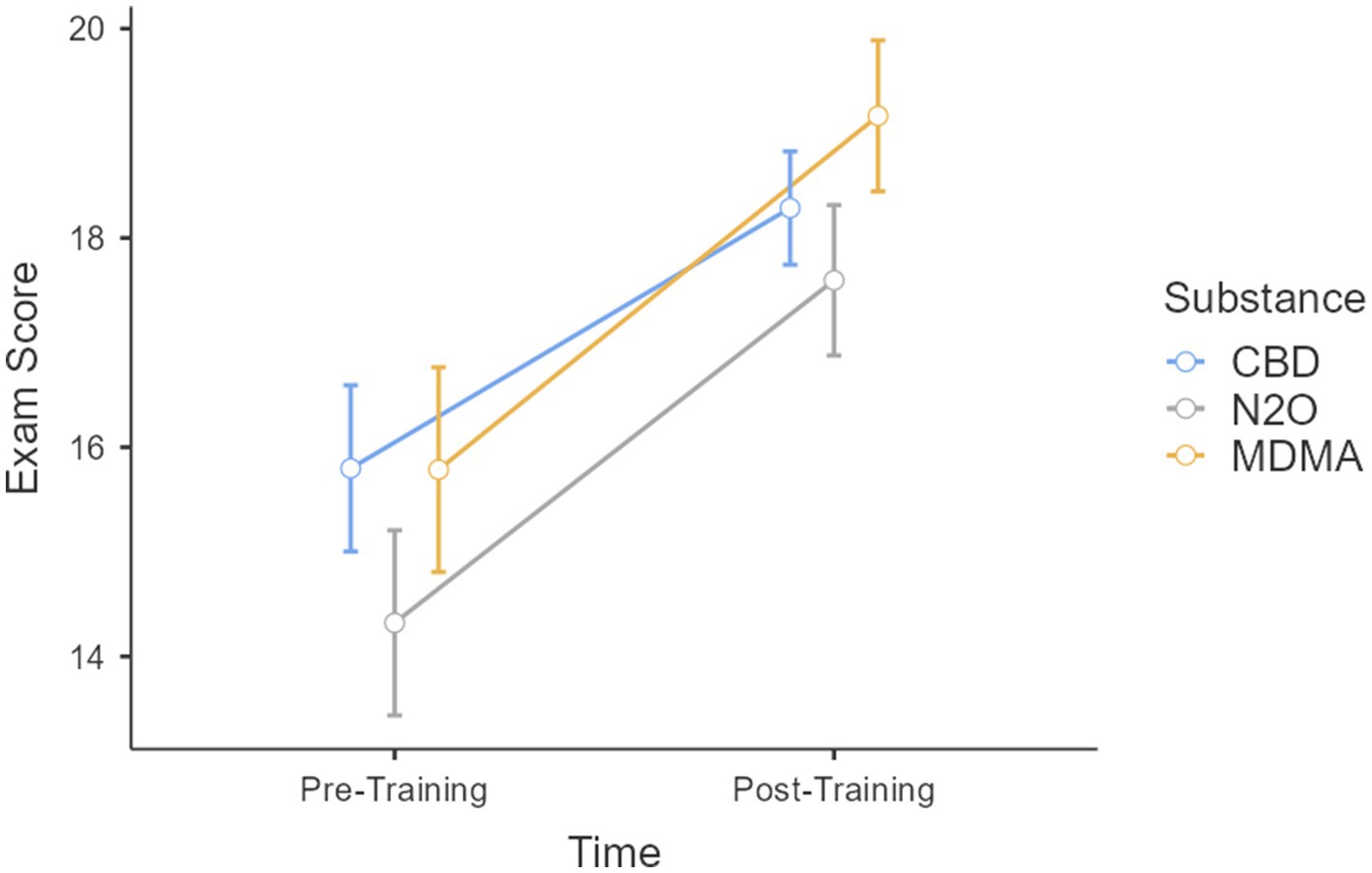
Figure 1. Score as a function of the time when completed (before and after training), and according to the substance involved (CBD, MDMA, N2O).
Results for Action 2 on effects on intentions to reduce their consumption regarding alcohol and tobacco, showed that sex emerged as a significant predictor. Males reported significantly higher intentions to reduce their consumption than females [β = 0.948, t(213.026) = 2.015, p = 0.045]. Age was also a significant predictor, with older participants reporting stronger intentions [β = 0.140, t(210,483) = 2.199, p = 0.029]. Participants informed about alcohol reported significantly lower intentions to drink [β = −1.061, t(213.986) = −2.167, p = 0.031]. However, amount of previous consumption was not statistically significant, although it showed a trend in which those who had previously consumed reported a higher intention to consume again [β = 1.360, t(213.387) = 1.894, p = 0.060]. Individuals with greater knowledge of the health effects of tobacco and alcohol reported higher intentions to reduce their consumption [β = 0.232, t(212.323) = 2.369, p = 0.019]. Concerning random effects, the variance associated with the intercept for the region was 2.053 with a standard deviation (SD) of 1.433 and an intraclass correlation coefficient (ICC) of 0.169. The residual variance was estimated to be 10.118 with an SD of 3.181. Results on effects on intentions to reduce their consumption regarding emerging substances showed that a total of 246 participants were evaluated (mean age = 21.9 years, SD = 3.8; 55.51% female). We found a marginally significant trend where participants informed about the effects of N2O showed only slightly increased intentions to reduce consumption [β = 0.932, t(190.386) = 1.792, p = 0.075]. We also found that participants with a history of substance use reported lower intentions to reduce their consumption [β = 2.414, t(192.945) = 3.879, p < 0.001]. Moreover, greater awareness was found to be associated with a small but significant increase in intentions to decrease substance use [β = 0.253, t(189.375) = 3.011, p = 0.003]. However, there was no significant effect of having been informed about other specific emerging substances (MDMA, CBD). The random effects analysis showed a standard deviation of the intercept across regions of 2.541, giving a variance of 6.458. This variability in the intercept corresponds to an intraclass correlation coefficient (ICC) of 0.413, suggesting that approximately 41.3% of the variability in intentions was due to differences between the regions. The residual standard deviation was 3.032 with a variance of 9.191.
Results for Action 3, showed that on effects on attitudes toward alcohol for participants with alcohol prevention posts, there was no significant age effect on attitudes toward alcohol [β = 0.008, t(145) = 0.429, p = 0.669], nor any sex effect [β = 0.151, t(145) = 0.615, p = 0.53]. Similarly, the proportion of correct responses to the questionnaire on the content of the posts showed no association with attitudes toward alcohol [β = 0.004, t(145) = 0.059, p = 0.953]. However, participants in the alcohol-exposure condition showed more negative attitudes toward alcohol [β = 0.342, t(145) = 2.534, p = 0.012]. This impact was not moderated by the number of correct responses to the alcohol questionnaire [t(145) = 0.181, p = 0.857] (Figure 2).
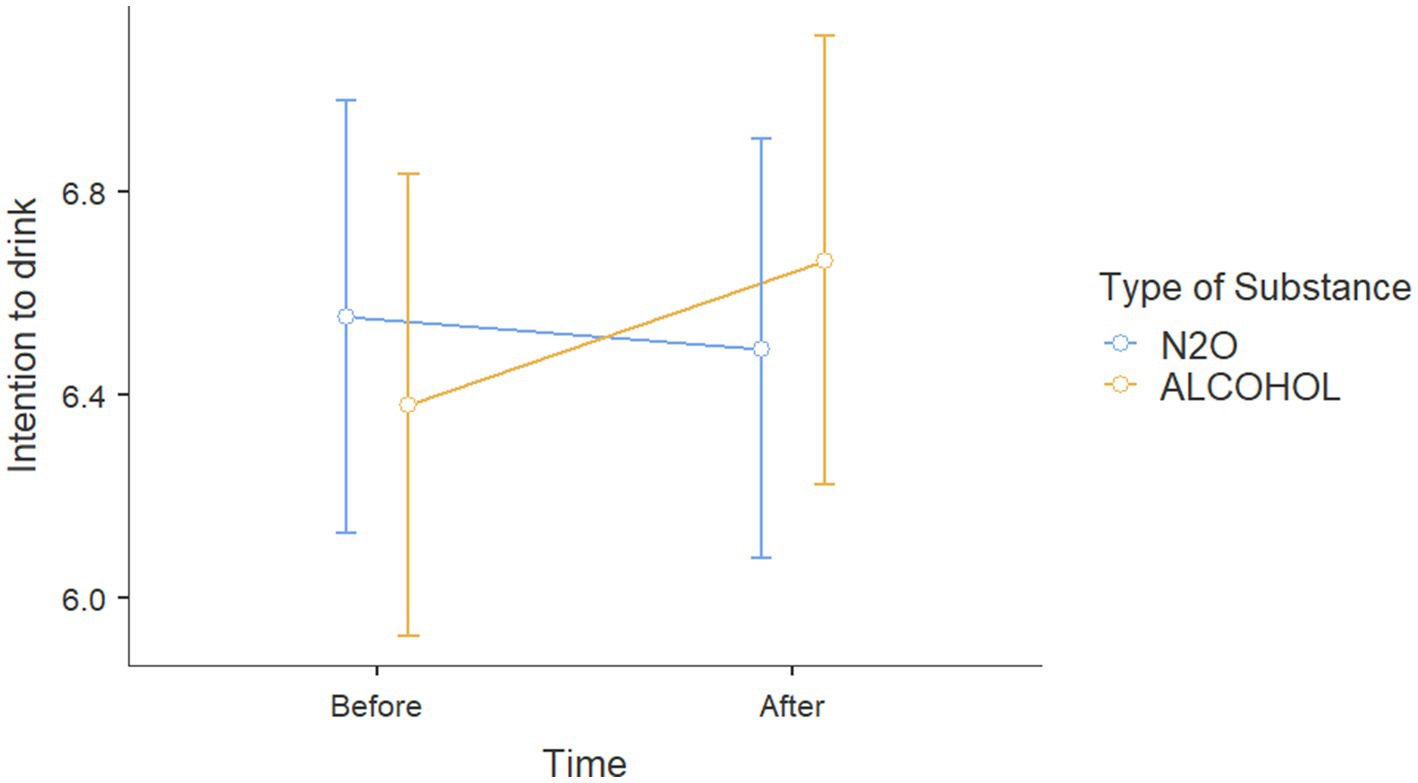
Figure 2. Scores at attitudes toward alcohol before and after viewing Instagram posts about either alcohol or N2O.
These results also showed on effects on attitudes toward nitrous oxide for participants with nitrous oxide prevention posts that the impact of exposure to N2O prevention posts was found to increase with the number of correct responses to the N2O questionnaire [β = −0.332, t(145) = −2.016, p = 0.046, ηp2 = 0.027]. This suggests that participants exposed to N2O information on social networks demonstrated more negative attitudes toward this substance when they achieved higher scores on the N2O questionnaire (Figure 3).
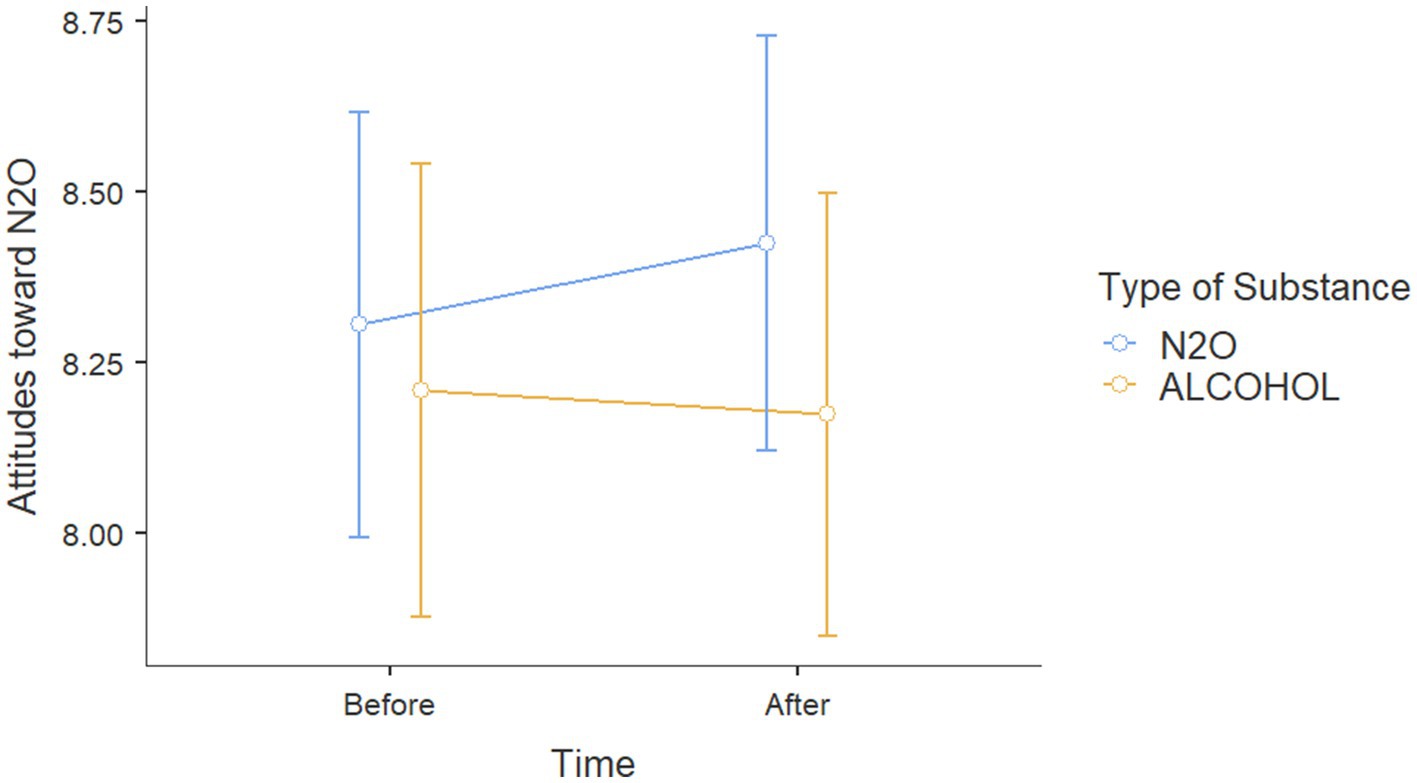
Figure 3. Attitude scores toward N2O before and after viewing Instagram posts about either alcohol or N2O.
Results for Action 3 showed on effects on intentions toward alcohol for participants with alcohol prevention posts no age effect [β = 0.362, t(116) = 1.256, p = 0.212, ηp2 = 0.013], sex effect [β = −5.301, t(116) = −1.469, p = 0.145, ηp2 = 0.018], correct response effect to the alcohol questionnaire [β = −0.940, t(116) = 0.358, p = 0.721, ηp2 = 0.001], or exposure type effect (alcohol vs. N2O, p = 0.618, ηp2 = 0.002) on intentions to consume alcohol (Figure 4).
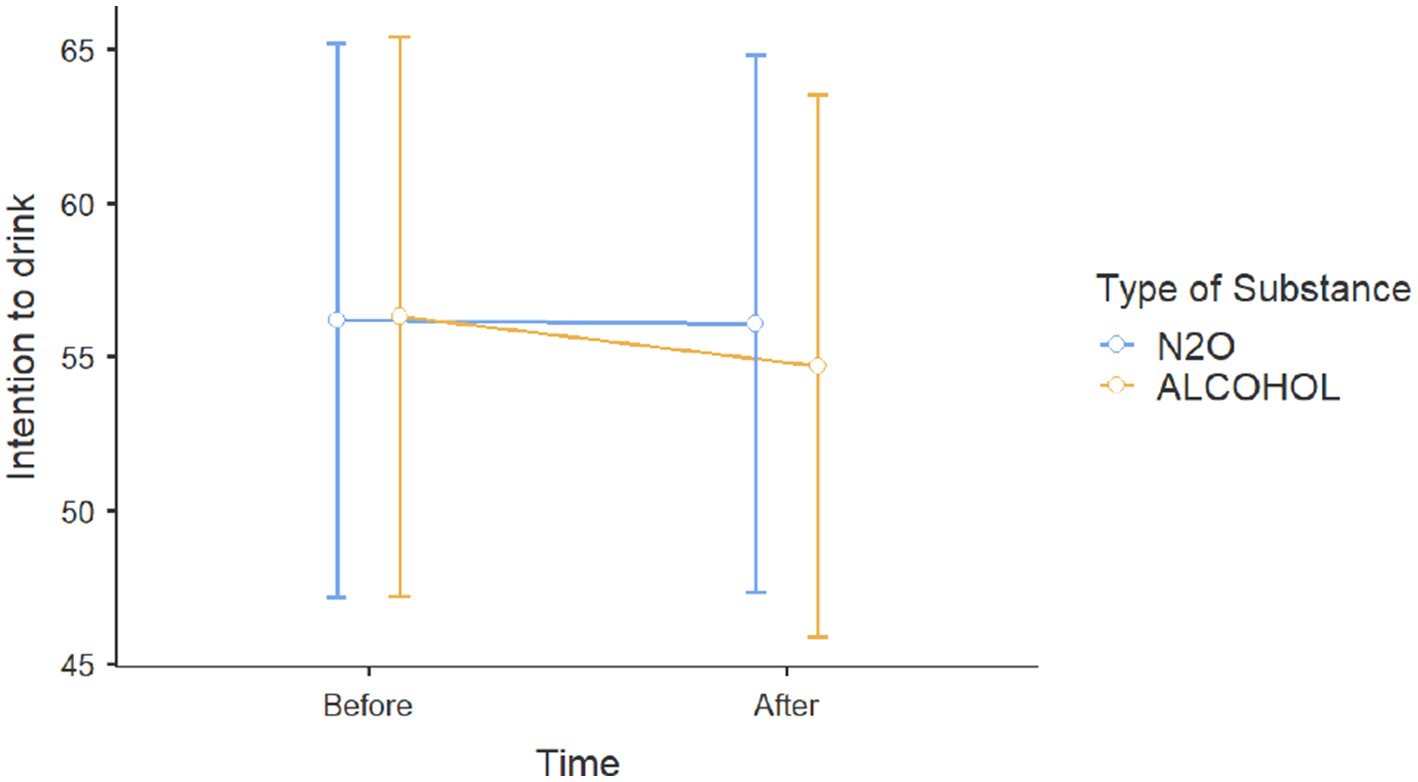
Figure 4. Scores on intention to consume alcohol before and after viewing Instagram posts about either alcohol or N2O.
Results showed on effects on intentions toward nitrous oxide for participants with nitrous oxide prevention posts no age effect [β = −0.403, t(64) = −0.278, p = 0.782, η2p = 0.001], no sex effect [β = −0.337, t(64) = −0.193, p = 0.847, ηp2 = 0.001], or exposure type effects were found on intentions to consume N2O (p < 0.17). No significant effect was observed (Figure 5).
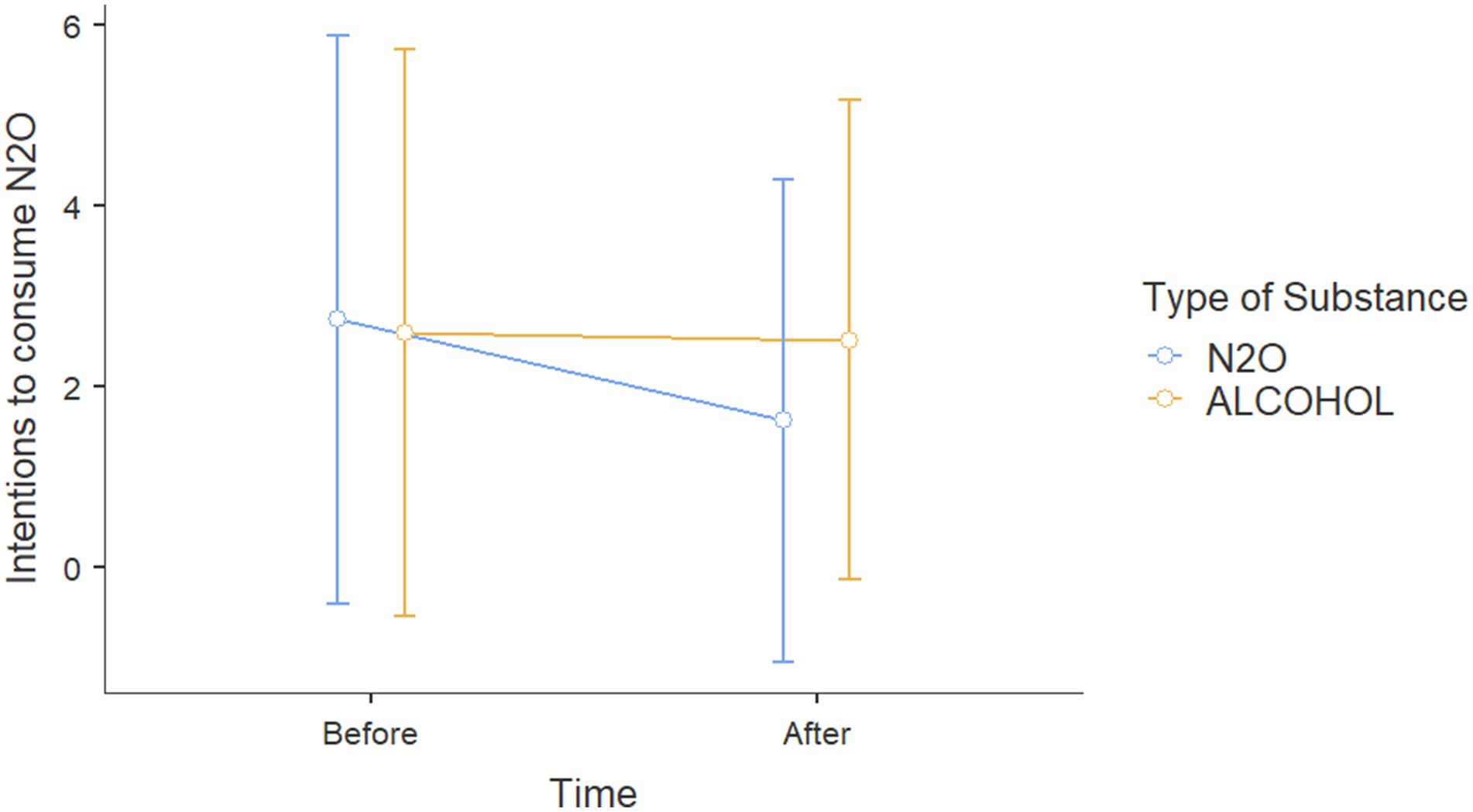
Figure 5. Intention to use N2O scores before and after viewing Instagram posts about either alcohol or N2O.
Results for Action 4 showed that exposure to alcohol prevention content led to more negative attitudes toward alcohol [F(1,124) = 3.86, p = 0.052, ηp2 = 0.03]. The other predictors had no significant effects on attitudes (see Figure 6). We found no significant effect on attitudes toward N2O (see Figure 7), on intentions to consume alcohol (p > 0.10) (see Figure 8) or on intentions to consume N2O (p > 0.10) (see Figure 9).
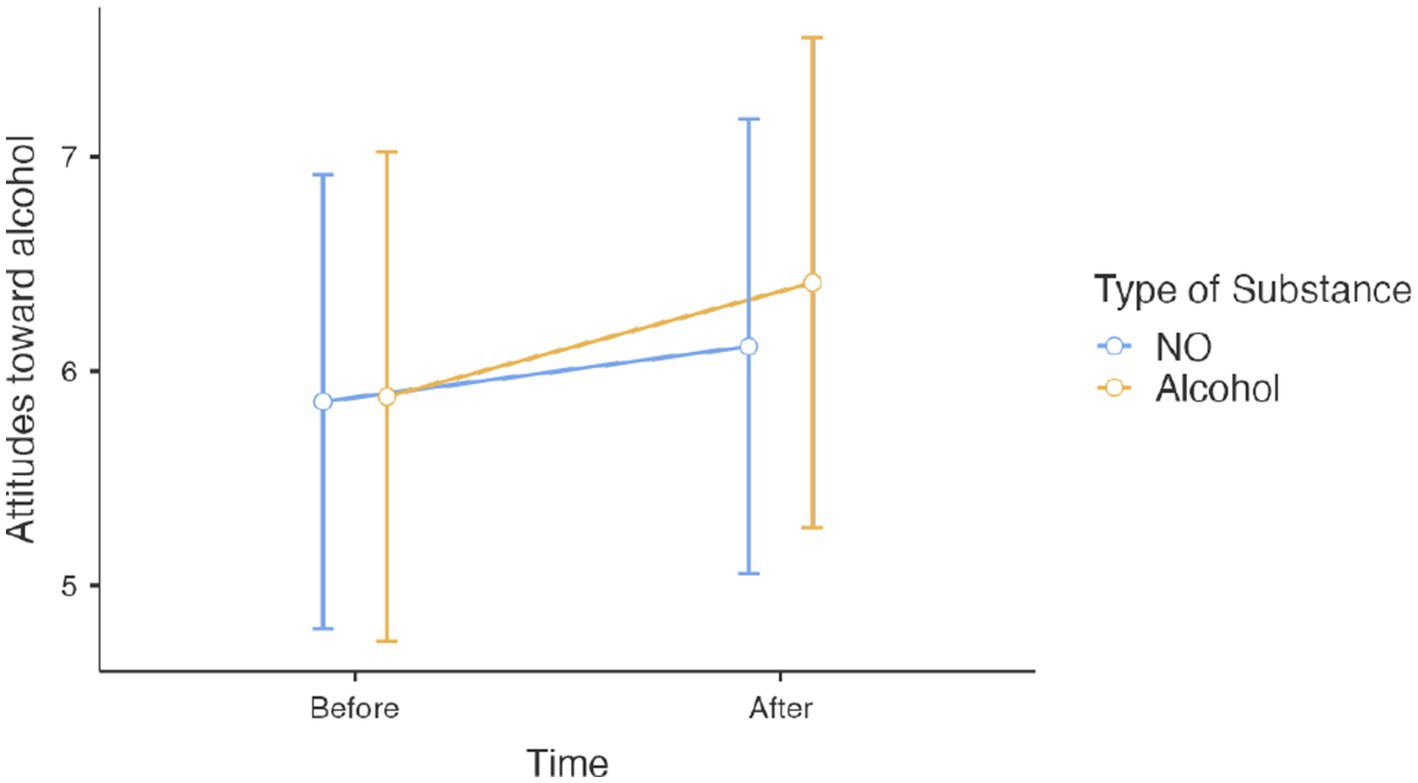
Figure 6. Scores for attitudes to alcohol before and after viewing the website for either alcohol or N2O.
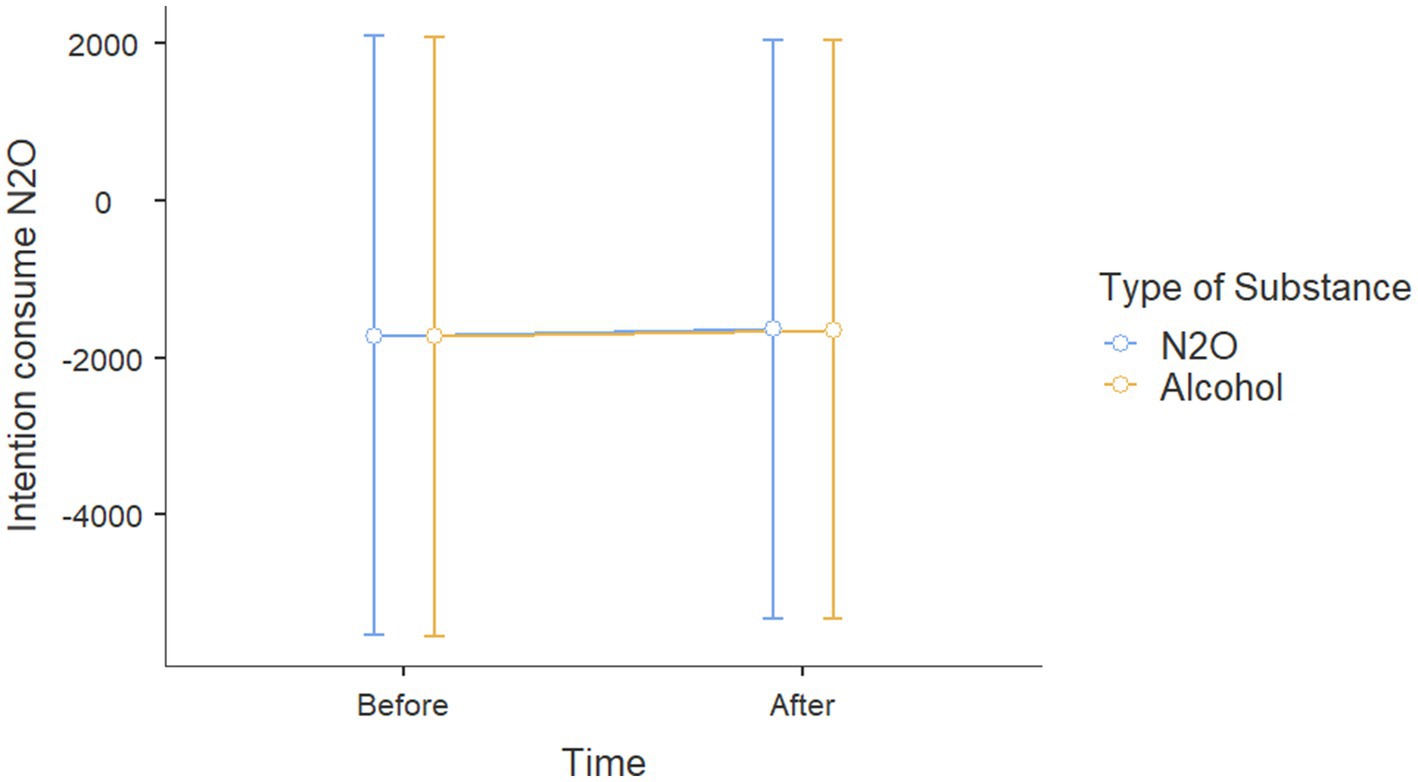
Figure 8. Scores for intentions to consume N2O before and after viewing the website for either alcohol or N2O.
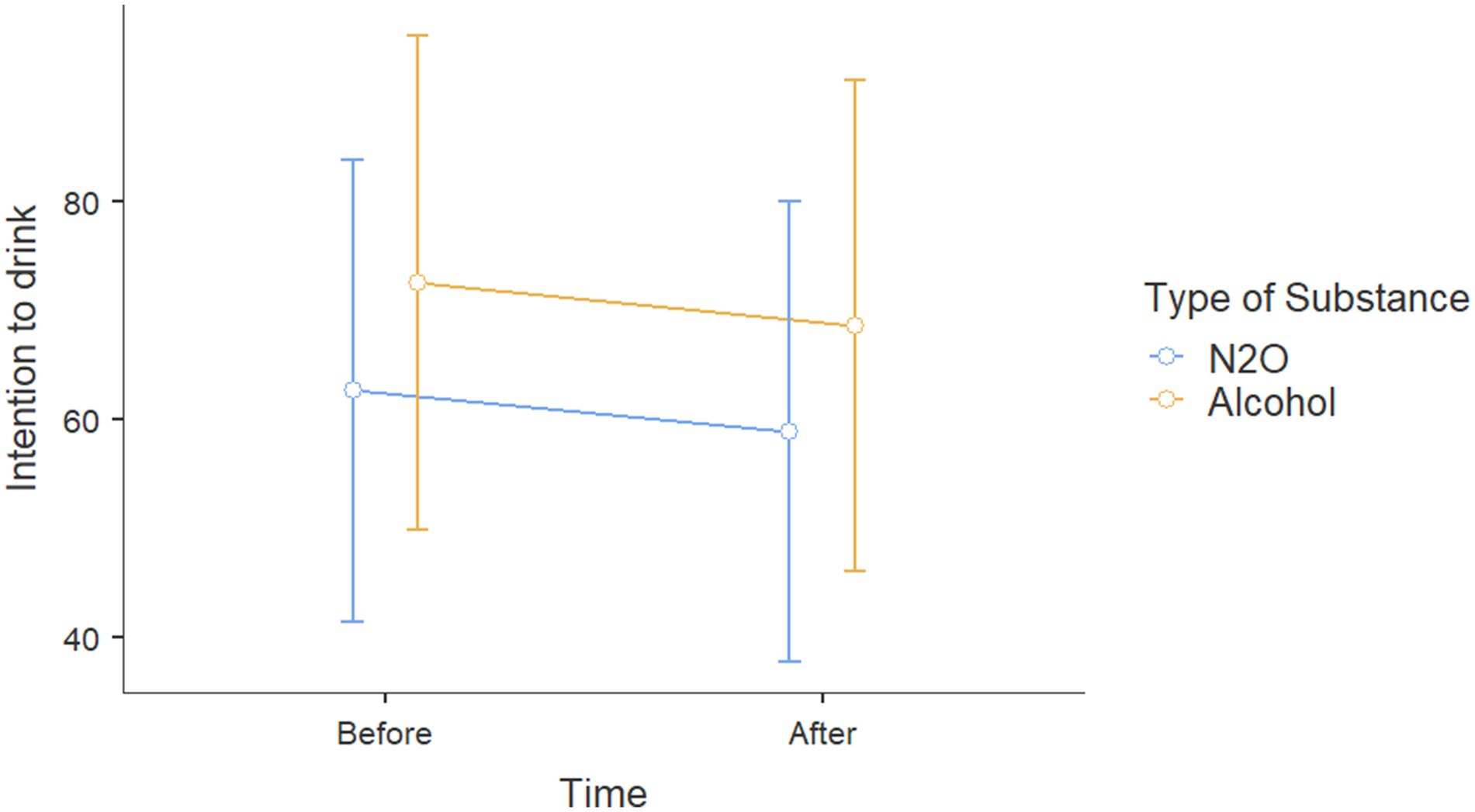
Figure 9. Scores for intentions to consume alcohol before and after viewing the website for either alcohol or N2O.
In response to a growing trend in psychoactive substance use among young adults aged 18 to 25, the Avenir Santé Association launched a prevention program specifically targeting ‘emerging substances’, primarily CBD, MDMA, and N2O. This multifaceted program had four key parts: (i) training of young volunteers or employees of the association, (ii) direct engagement with young people in popular gathering areas, (iii) use of Instagram for prevention outreach, and (d) awareness raising of party organizers through a dedicated website, montetasoiree.com. The impact evaluation of the program yielded encouraging results. Training participants demonstrated an increased understanding of psychoactive substances, particularly MDMA—a substance that was previously less well understood. This confirmed the effectiveness of the training in increasing knowledge, particularly in areas where knowledge was initially lacking. More precisely, our results showed a general increase in knowledge of all the psychoactive substances studied. An interesting pattern was observed in the change in knowledge from the beginning to the end of the training session: the most pronounced increase in knowledge was for MDMA, followed by CBD and N2O. This suggests that the training was particularly effective in promoting understanding of MDMA, possibly owing to the nature of the information presented or the receptiveness of the participants to this particular topic.
Concerning direct action with young people, we found a significant association between knowledge of the health effects of substance use and intention to reduce consumption. This underlines the importance of educational programs that inform potential users about the possible negative health effects of substance use. Age and sex emerged as significant predictors of intentions to reduce substance consumption. Older persons and males were found to have more intention to reduce their consumption of alcohol and tobacco. This could reflect a greater awareness or experience of the negative effects of substance use in older populations (Degenhardt et al., 2007) and males (Becker and Hu, 2008), or it might relate to societal expectations and pressures, which differ by age and sex. Interventions should therefore be tailored to the specific needs and concerns of different demographic groups. We found that exposure to discourse about alcohol during an outreach session had a clear statistically significant effect on participants’ intentions to use alcohol. Discussions about N2O showed a marginally significant effect on intentions to use new substances. These findings suggest that what substance is being addressed during outreach initiatives can modulate consumption intentions. However, although the specific topic of the outreach discourse plays a role, the continued importance of intrinsic motivations for substance uses in shaping overall consumption patterns must be emphasized. The findings suggest that interventions aimed at reducing substance use should focus on increasing knowledge about health effects (White et al., 2010), especially for emerging substances. They should also target specific populations across different regions, taking into account regional variations and the demographic factors age and sex (White et al., 2010; Cerdá et al., 2011).
On actions using social networks, exposure to Instagram posts on the effects of addictive substances seemed to affect judgments about these substances. Participants exhibited more negative attitudes toward alcohol when they were exposed to posts about alcohol. Similarly, attitudes toward N2O were more negative when participants were exposed to prevention posts about N2O and retained information about its effects. This suggests that online prevention campaigns can be effective in changing attitudes and perceptions about substances, which could potentially impact future consumption behaviors. This is in line with previous results observed on a prevention program on Facebook (Flaudias et al., 2015). Despite changing attitudes toward substances, the study found that exposure to the Instagram posts did not significantly affect intentions to consume these substances. Importantly, although attitudes can influence behavior, they do not necessarily translate into actual behavior change. For example, according to the theory of planned behavior (Ajzen, 1991), intention is the most proximal determinant of behavior. However, intention itself is influenced not only by attitudes toward the behavior, but also by several other factors such as subjective norms (perceived social pressure to enact or not enact the behavior) and perceived behavioral control (the extent to which a person feels able to enact the behavior). In our context, it could be that the exposure to Instagram posts primarily affected the attitudes toward substance use, but it might not have significantly influenced subjective norms or perceived behavioral control. For example, although young persons developed negative attitudes toward substances after seeing the Instagram posts, they might still perceive high peer pressure to consume substances (subjective norms), or they might not feel they have much control over their substance use behavior (perceived behavioral control). These factors could counteract their changed attitudes, and result in unchanged intentions to consume substances. Another factor to consider is the gap between intentions and actual behaviors, which can be influenced by a range of factors including forgetting, distraction, and changes in situation or context. That intentions have been affected does not necessarily guarantee a change in actual behavior. The effectiveness of health messages in social media depends on how the messages are designed and presented. If the Instagram posts did not use persuasive techniques effectively (e.g., by not sufficiently tailoring the messages to the target audience, or by not presenting the information in a compelling way), the impact on the viewers’ intentions could be limited. This suggests that whereas the campaign was effective at increasing awareness and changing perceptions, more intensive or different types of intervention might be needed to change consumption intentions and behavior (Wakefield et al., 2010). Interestingly, it was found that the more accurately the participants retained information from the posts about the respective substances (alcohol or N2O), the stronger the change in their attitudes. This points to the importance of clear and effective communication in such campaigns. The more successfully the message is delivered and understood, the greater the potential impact on attitudes. Age and sex did not significantly affect attitudes or intentions toward alcohol or N2O, showing that the observed effects of the prevention campaign were consistent across different demographic groups in this sample. Regarding intentions to consume emerging substances, we note that participants had extremely low scores to begin with and that these remained very low (about 3% of respondents) throughout the study. This could mean that because the prevention messages were affirming already low intentions to use, little change was elicited.
In conclusion, while the prevention campaign on social network influenced participants’ attitudes toward alcohol and N2O, it did not appear to impact their consumption intentions. This suggests that future campaigns may need to couple information dissemination with additional strategies to effectively reduce substance use intentions and behaviors. However, our results highlight the potential power of social media as a platform for health communication and intervention.
Overall, Action 4 shows that the presentation of information via a website did not have any significant effect on the consumption intentions of alcohol or emerging substances. Nor was there any observed effect on attitudes toward emerging substances. We found no significant change in the participants’ intentions to consume alcohol or N2O after exposure to web pages providing information about these substances. This suggests that the website content was not persuasive enough to change behavior intentions or that the participants were already aware of the effects of these substances. Despite exposure to the website’s content about emerging substances, no significant effect was observed on participants’ attitudes toward these substances. One interpretation could be that the participants either already held strong attitudes that were not swayed by the website content, or the content was not engaging or convincing enough to alter the participants’ attitudes. However, the prevention content about alcohol did lead to slightly more negative attitudes toward alcohol although the effect was at the threshold of significance. Hence the website could potentially shape the attitudes of its users toward alcohol consumption, even though it failed to influence their actual intentions to consume alcohol or other substances. The fact that the Action 4 sample consisted mainly of students rather than party organizers may partly explain these observations. A targeted evaluation involving people interested in organizing parties, such as members of student unions, might therefore yield different findings.
Our evaluation has some limitations. The first action is based on self-observation, and there may be a test-retest effect. Even so, we observed an overall improvement in all items.
Although the results provide an encouraging indication of the effectiveness of the training, the modest sample size limits generalizability. Future research with larger participant pools will help validate these findings and further explore the impact of such training sessions on improving knowledge about psychoactive substances. Subsequent research can also explore the factors that influence different rates of learning for different substances, in order to optimize the design and content of the training.
In Action 2, there may have been some selection bias, since the evaluations may have targeted the people who were the most satisfied with the intervention, and therefore probably the most sensitive to the discourse. Further, by asking about behavioral intentions immediately after the intervention, we were not assessing the reflection that the exchange might have elicited, and which could have ultimately modified behavioral intentions. The interviews were also of short duration (13 min, SD = 6 min). Actions 3 and 4 were carried out with psychology students, a population which, although part of the target population for Avenir Santé Association interventions, may not accurately represent the total population targeted by Avenir Santé Association. It would be of interest to replicate the study controlling for respondents staying the same amount of time on the website, a pitfall that was not present for the Instagram posts. Secondly, it would be necessary to ensure that the amount of information to be retained is the same for both communication modalities. It is possible that the information presented via social networks was (i) less abundant and (ii) presented in a way that makes it easier to retain. Actions 3 and 4 were carried out with psychology students, a population that, although part of the target population for Avenir Santé Association interventions, may not accurately represent the total population targeted by Avenir Santé Association.
The program implemented by Avenir Santé Association offers a compelling framework for substance misuse prevention. The program’s efficacy was reflected in the notable proficiency enhancement observed among trained facilitators and an appreciable upsurge in knowledge about emerging substance use trends. Additionally, some individuals demonstrated a promising inclination to reduce their substance consumption. The program’s field interventions fostered an enhanced understanding and amplified aversive attitudes toward a range of substances comprising alcohol, tobacco, CBD, MDMA, and N2O among young people. They did not, however, elicit an intent to diminish the consumption of emergent substances, likely owing to the current low usage rate (3%) in the youth population.
The influence of social media as a preventive tool was underlined by a discernable shift in attitudes among young individuals exposed to Instagram posts regarding N2O. This underscores the potential of digital platforms for shaping perceptions and catalyzing behavior modification. While these findings contribute significantly to the field, we emphasize that influencing attitudes does not invariably cause behavior change. Future interventions should therefore integrate these insights to frame multifaceted strategies that extend beyond awareness and education, thereby achieving a greater impact on consumption behaviors.
The raw data supporting the conclusions of this article will be made available by the authors, without undue reservation.
The studies involving humans were approved by Comité d’éthique, de déontologie et d’intégrité scientifique (CEDIS) de Nantes Université (No. IRB: IORG0011023). The studies were conducted in accordance with the local legislation and institutional requirements. The participants provided their written informed consent to participate in this study.
OZ: Conceptualization, Formal analysis, Methodology, Project administration, Writing – original draft, Writing – review & editing. SL: Conceptualization, Funding acquisition, Investigation, Project administration, Resources, Writing – review & editing. RB: Funding acquisition, Methodology, Project administration, Resources, Writing – review & editing. VF: Conceptualization, Methodology, Project administration, Supervision, Writing – original draft, Writing – review & editing.
The author(s) declare that financial support was received for the research, authorship, and/or publication of this article. The project was funded for the implementation of the protocol and/or its evaluation by the “Fonds de Lutte contre les Addictions.”
The authors thank the staff of Avenir Santé Association for their unstinting help with data collection, their skilled management of the logistic and administrative aspects of the research, which ensured that it proceeded smoothly and efficiently, and their expertise, commitment, and unwavering support in bringing this project to fruition. It was a pleasure and an honor to work with such a dedicated team.
The authors declare that the research was conducted in the absence of any commercial or financial relationships that could be construed as a potential conflict of interest.
All claims expressed in this article are solely those of the authors and do not necessarily represent those of their affiliated organizations, or those of the publisher, the editors and the reviewers. Any product that may be evaluated in this article, or claim that may be made by its manufacturer, is not guaranteed or endorsed by the publisher.
The Supplementary material for this article can be found online at: https://www.frontiersin.org/articles/10.3389/fpsyg.2024.1339751/full#supplementary-material
Ajzen, I. (1991). Theories of cognitive self-regulation the theory of planned behavior. Organ. Behav. Hum. Decis. Process. 50, 179–211. doi: 10.1016/0749-5978(91)90020-T
Batalla, A., Bos, J., Postma, A., and Bossong, M. G. (2021). The impact of cannabidiol on human brain function: a systematic review. Front. Pharmacol. 11:618184. doi: 10.3389/fphar.2020.618184
Becker, J. B., and Hu, M. (2008). Sex differences in drug abuse. Front. Neuroendocrinol. 29, 36–47. doi: 10.1016/j.yfrne.2007.07.003
Cerdá, M., Johnson-Lawrence, V., and Galea, S. (2011). Lifetime income patterns and alcohol consumption: investigating the association between long- and short-term income trajectories and drinking. Soc. Sci. Med. 73, 1178–1185. doi: 10.1016/j.socscimed.2011.07.025
Cohen, L., Duroy, D., Perozziello, A., Sasportes, A., Lejoyeux, M., and Geoffroy, P. A. (2023). A cross-sectional study: nitrous oxide abuse in Parisian medical students. Am. J. Addict. 32, 60–65. doi: 10.1111/ajad.13363
Cole, J. C., and Sumnall, H. R. (2003). The pre-clinical behavioural pharmacology of 3,4-methylenedioxymethamphetamine (MDMA). Neurosci. Biobehav. Rev. 27, 199–217. doi: 10.1016/S0149-7634(03)00031-9
Degenhardt, L., Chiu, W. T., Sampson, N., Kessler, R. C., and Anthony, J. C. (2007). Epidemiological patterns of drug use in the United States: evidence from the National Comorbidity Survey Replication, 2001–2003. Drug Alcohol Depend. 90, 210–223. doi: 10.1016/j.drugalcdep.2007.03.007
Ferreira, P. M., Alves, R. J. R., and Zantut-Wittmann, D. E. (2022). Impact of the use of illicit and licit substances and anxiety disorders on the academic performance of medical students: a pilot study. BMC Med. Educ. 22:684. doi: 10.1186/s12909-022-03752-6
Flaudias, V., de Chazeron, I., Zerhouni, O., Boudesseul, J., Begue, L., Bouthier, R., et al. (2015). Preventing alcohol abuse through social networking sites: a first assessment of a two-year ecological approach. J. Med. Internet Res. 17:e278. doi: 10.2196/jmir.4233
Inquimbert, C., Maitre, Y., Moulis, E., Gremillet, V., Tramini, P., Valcarcel, J., et al. (2022). Recreational nitrous oxide use and associated factors among health profession students in France. Int. J. Environ. Res. Public Health 19:5237. doi: 10.3390/ijerph19095237
Kempf, C., Llorca, P.-M., Pizon, F., Brousse, G., and Flaudias, V. (2017). What’s new in addiction prevention in young people: a literature review of the last years of research. Front. Psychol. 8:1131. doi: 10.3389/fpsyg.2017.01131
Lundin, M. S., Cherian, J., Andrew, M. N., and Tikaria, R. (2019). One month of nitrous oxide abuse causing acute vitamin B 12 deficiency with severe neuropsychiatric symptoms. BMJ Case Rep. 12:e228001. doi: 10.1136/bcr-2018-228001
Millar, S. A., Stone, N. L., Bellman, Z. D., Yates, A. S., England, T. J., and O’Sullivan, S. E. (2019). A systematic review of cannabidiol dosing in clinical populations. Br. J. Clin. Pharmacol. 85, 1888–1900. doi: 10.1111/bcp.14038
Parrott, A. C. (2005). Chronic tolerance to recreational MDMA (3,4-methylenedioxymethamphetamine) or ecstasy. J. Psychopharmacol. 19, 71–83. doi: 10.1177/0269881105048900
Peroutka, S. J. (1989). Ecstasy: the clinical, pharmacological and neurotoxicological effects of the drug MDMA. New York, NY: Springer Science & Business Media.
Piper, B. J. (2007). A developmental comparison of the neurobehavioral effects of ecstasy (MDMA). Neurotoxicol. Teratol. 29, 288–300. doi: 10.1016/j.ntt.2006.10.002
Ponce-Blandón, J. A., Martínez-Montilla, J. M., Pabón-Carrasco, M., Martos-García, R., Castro-Méndez, A., and Romero-Castillo, R. (2021). International multicenter study on drug consumption in nursing students. Int. J. Environ. Res. Public Health 18:9526. doi: 10.3390/ijerph18189526
Redmond, J., Cruse, B., and Kiers, L. (2022). Nitrous oxide-induced neurological disorders: an increasing public health concern. Intern. Med. J. 52, 740–744. doi: 10.1111/imj.15544
Rudisill, T. M., Innes, K., Wen, S., Haggerty, T., and Smith, G. S. (2023). The effects of cannabidiol on subjective states, cognition, and psychomotor function in healthy adults: a randomized clinical trial. Fundam. Clin. Pharmacol. 37, 663–672. doi: 10.1111/fcp.12868
van den Bos, A., Blaauw, E., and Bieleman, B. (2022). University students and the normalisation of illicit recreational drug use. J. Youth Stud. 26, 894–906. doi: 10.1080/13676261.2022.2053668
Vollenweider, F. X., Liechti, M. E., Gamma, A., Greer, G., and Geyer, M. (2002). Acute psychological and neurophysiological effects of MDMA in humans. J. Psychoactive Drugs 34, 171–184. doi: 10.1080/02791072.2002.10399951
Wakefield, M. A., Loken, B., and Hornik, R. C. (2010). Use of mass media campaigns to change health behaviour. Lancet 376, 1261–1271. doi: 10.1016/S0140-6736(10)60809-4
Wheeler, M., Merten, J. W., Gordon, B. T., and Hamadi, H. (2020). CBD (cannabidiol) product attitudes, knowledge, and use among young adults. Subst. Use Misuse 55, 1138–1145. doi: 10.1080/10826084.2020.1729201
Keywords: prevention, ecstasy, cannabidiol, nitrous oxide, field interventions
Citation: Zerhouni O, Loisy S, Bouthier R and Flaudias V (2024) Preventing new substance use behaviors in youth: evaluation of a two-year comprehensive program. Front. Psychol. 15:1339751. doi: 10.3389/fpsyg.2024.1339751
Received: 16 November 2023; Accepted: 14 June 2024;
Published: 05 July 2024.
Edited by:
Alejandra Fernandez, University of Texas Health Science Center at Houston, United StatesReviewed by:
Souparno Mitra, New York University, United StatesCopyright © 2024 Zerhouni, Loisy, Bouthier and Flaudias. This is an open-access article distributed under the terms of the Creative Commons Attribution License (CC BY). The use, distribution or reproduction in other forums is permitted, provided the original author(s) and the copyright owner(s) are credited and that the original publication in this journal is cited, in accordance with accepted academic practice. No use, distribution or reproduction is permitted which does not comply with these terms.
*Correspondence: Valentin Flaudias, VmFsZW50aW4uZmxhdWRpYXNAdW5pdi1uYW50ZXMuZnI=
Disclaimer: All claims expressed in this article are solely those of the authors and do not necessarily represent those of their affiliated organizations, or those of the publisher, the editors and the reviewers. Any product that may be evaluated in this article or claim that may be made by its manufacturer is not guaranteed or endorsed by the publisher.
Research integrity at Frontiers

Learn more about the work of our research integrity team to safeguard the quality of each article we publish.